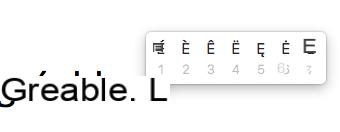With ASCII codes under Windows
This method works in many Windows software and allows you to enter accented uppercase letters by holding the Alt key then entering the corresponding code, of which the following are the most used:
- Á = Alt + 181
- To = Alt + 183
- Â = Alt + 182
- Ç = Alt + 128
- It is = Alt + 212
- Is = Alt + 144
- Ê = Alt + 210
- Ñ = Alt + 165
- Ö = Alt + 153
- Ù = Alt + 235
- Π= Alt + 0140
Windows shortcuts
More tedious, this method allows you to enter capital letters using two successive keyboard shortcuts, the first to choose the accent and the second to enter the capital letter. The accent shortcuts are: "Ctrl + Alt + 7" for the grave accent and "Ctrl + 4" for the acute accent.
For example, you will have to use the shortcut Ctrl + Alt + 7 then Shift + A to insert a "To",
The method in macOS
Just like in Windows, macOS has some complicated key combinations to remember. The new method is much simpler because you just need to press and hold the key. May then that of the desired letter.

While holding the two keys, a pop-up window displays the different choices available that the user can choose with the mouse or according to the number of the capital letter.
Combinations under Linux
The method on Linux is rather simple because you just need to press Verr. Maj then on the accented lowercase key to obtain the corresponding uppercase. For the letter "É", you simply have to perform and hold the key combination Verr Maj + is.
The classic copy and paste
One of the easiest methods is also to perform a simple copy and paste between a web page and its document. Here are the main accented capitals:
Á Â Ä Ã Æ Ç É È Ê Ë Î Ï Ø Ø OE Û Ü Y
Finally, note that the Bépo keyboard, an alternative to the classic AZERTY, allows you to simply enter the accented capitals by pressing Shift and the accented lower case.


























